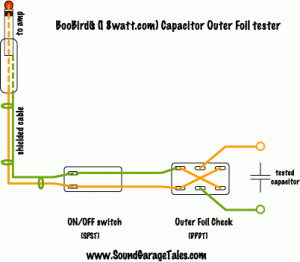Capacitor, Be Quiet!
In guitar amps, we always battle the signal-to-noise ratio. Of course we could never have the ideal guitar amp in this life because we are limited by the components we use that will dictate the final guitar tone and noise. And to be honest we don’t even need to push for a complete noiseless amp otherwise we would slide into the Hi-Fi zone and that’s NOT a field for tube guitar amps.
All we can do is try to limit any sort of residual noise by proper grounding techniques, wire dressing, etc. Another trick we can use is making sure we properly orient the coupling capacitors (non-polarized) outer foil side in our circuit stages. Check this video I made that shows you how much noise is induced on a particular orientation and how much quieter is in the other.
Why the hustle?
A non-polarized capacitor’s construction typically is somewhat similar to a double burrito. You take one flower tortilla, add the filling (re-fried beans, salsa, cheese, sour cream), flap another flower tortilla on top, and roll it up like a blanket. The only difference is that you have two metallic foils, with some sort of dielectric in the middle. There is an excellent article on dissecting capacitors on Mark Huss’s web site.
One of the foils will end up on the outside, the other, however completely wrapped on the inside. The outside foil ends up acting as a “shield” much like a regular shielded cable.
Properly connecting the outer foil of a non-polarized capacitor in our circuit stages can save us from a guitar amp that picks up about any possible induced residual noise.
Which End Goes Where?
 If a signal travels into a coupling capacitor (for instance, fed in from the plate of a preamp tube), and enters the outside foil side, this will act as a shield, minimizing any possible induced noise interference such as the 60Hz (or 50Hz) to it. So, as a rule of thumb it would be to connect the outer capacitor foil to the incoming signal point or in a more technical phrase, to the lower impedance stage. For capacitors that are used in tone stacks, connect the outer foil to the ground.
If a signal travels into a coupling capacitor (for instance, fed in from the plate of a preamp tube), and enters the outside foil side, this will act as a shield, minimizing any possible induced noise interference such as the 60Hz (or 50Hz) to it. So, as a rule of thumb it would be to connect the outer capacitor foil to the incoming signal point or in a more technical phrase, to the lower impedance stage. For capacitors that are used in tone stacks, connect the outer foil to the ground.
Discover Your Outer Foil!
Capacitor manufacturers don’t necessarily listen to your burden of minimizing the noise level so there are only a few of them who mark the outside foil orientation on the capacitor.. That means that you will have to find out where is the outer foil on a capacitor, mark it and connect it the right way in your circuits. It really all comes down to a short auditive or visual test. Or if you REALLY want to be sure, both.
Use Your Ears Test
 BooBird from the 18watt forums came up with a handy old school capacitor outer foil tester box to discover the outer foil by listening to the amount of noise induced into a guitar amp. It the simplest construction. Here is my version of it.
BooBird from the 18watt forums came up with a handy old school capacitor outer foil tester box to discover the outer foil by listening to the amount of noise induced into a guitar amp. It the simplest construction. Here is my version of it.
It simply has two switches, an ON/OFF (SPDT) to shunt (short) your guitar amp’s input so it won’t buzz till you connect a cap to the alligator clips, and a Outer Foil Switch (DPDT) that will indicate the side where the outer foil is on the cap.
 The wiring is very simple, and it’s functionality is simply to listen to the buzz level indicating which side is connected to the guitar amp input.
The wiring is very simple, and it’s functionality is simply to listen to the buzz level indicating which side is connected to the guitar amp input.
If the outer foil is connected to the guitar amp input, the buzz will be strong since the orientation is opposite to the signal flow (into the outer foil first).
 I have my DPDT wired in such way that the bat indicates the capacitor’s foil side.
I have my DPDT wired in such way that the bat indicates the capacitor’s foil side.
Use Your Eyes Test
 And of course the more classic way of testing the outer foil for those of you who own an oscilloscope.
And of course the more classic way of testing the outer foil for those of you who own an oscilloscope.
Simply set your scope for an AC reading of less than 20mV (I have it here set to 10mV), grab the capacitor tightly between your fingers to induce the 60Hz hum – believe it or not, you are a big hum inducer, my friend – and connect the tip and the ground probe to the leads.
 On your lowest reading notice the lead that is connected to your scope’s ground lead (usually the one with the alligator clip on it). That is your outer foil – mark it on the capacitor!
On your lowest reading notice the lead that is connected to your scope’s ground lead (usually the one with the alligator clip on it). That is your outer foil – mark it on the capacitor!
You are done!



 Facebook Page
Facebook Page Flickr Photos Sets
Flickr Photos Sets Twitter
Twitter YouTube Channel
YouTube Channel Subscribe to SGT!
Subscribe to SGT!
